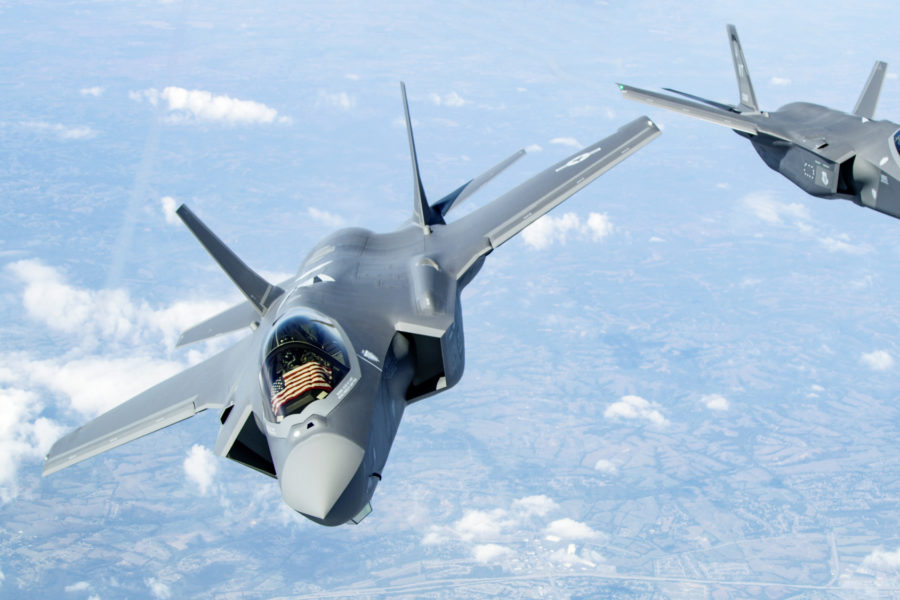The F-35 Lightning II is a multirole, stealthy, penetrating, all-weather fighter/attack family of tactical aircraft developed under the multinational Joint Strike Fighter program.
USAF’s conventional F-35A is complemented by the F-35B short takeoff and vertical landing (STOVL) version for USMC, and the carrier-capable F-35C for the Navy. The X-35 demonstrator first flew on Oct. 24, 2000, winning the go-ahead for the F-35A which first flew in developmental form in 2006.
 Lightning II is planned to replace the A-10 and some F-16s, offering better penetrating capability against advanced A2/AD threats to strike heavily defended targets. USAF’s F-35A can carry up to 22,000 lb of weapons on 10 stations: two internal bays for stealth, and/or six wing and fuselage pylons for max loadout.
Lightning II is planned to replace the A-10 and some F-16s, offering better penetrating capability against advanced A2/AD threats to strike heavily defended targets. USAF’s F-35A can carry up to 22,000 lb of weapons on 10 stations: two internal bays for stealth, and/or six wing and fuselage pylons for max loadout.
Air Force F-35s first saw combat on April 30, 2019, during Inherent Resolve. The current fleet-standard Block 3F software gives the F-35A full combat capability with an array of precision guided weapons across mission sets including interdiction, basic CAS, and limited SEAD. The next Block 4 iteration will give the F-35A a new maritime strike role and add weapons including the nuclear B61-12, developmental Stand-in Attack Weapon (SiAW), and SDB II, as well as APG-185 radar sensor and EW improvements.
Block 4 also corrects deficiencies discovered in concurrent development/testing but is roughly three years behind schedule. USAF is continuing low-rate delivery to minimize future retrofits. The Lot 15 through 17 production deal agreed in December 2022 will include the first Tech Refresh 3 (TR-3) aircraft specifically equipped to support Block 4 retrofit. TR-3 flight-testing began in January 2023, and Continuous Capability Development and Delivery (C2D2) will provide ongoing development and modernization.
The F-35A also requires increased engine performance to fully exploit Block 4. Both GE and Pratt & Whitney tested prototype engines that offered as much a 30 percent range increase, but USAF opted for an Engine Core Upgrade to the current power plant instead on cost and variant-interoperability grounds. F-35 deliveries were halted for three months following the engine-related crash of an F-35B in December 2022.
All three variants will now undergo engine modifications to correct harmonic resonance issues. The F-35 program aims to complete operational testing this year, enabling a full-rate production decision and future cost-saving mutiyear block buys. Operational testing was originally slated for completion in 2019. Congress added FY23 funds to procure 43 airframes, 10 more than the service initially requested. The Czech Republic announced plans to purchase 24 F-35s in July 2022, joining Germany, Finland, and Switzerland as recent allied customers for the jet.
Contractors: Lockheed Martin; BAE Systems; Northrop Grumman; Pratt & Whitney (engine).
First Flight: Dec. 15, 2006.
Delivered: April 2011-present.
IOC: Aug. 2, 2016.
Production: Planned: 1,763 (USAF F-35As).
Inventory: 354 (USAF).
Operator: ACC, AETC, AFMC, AFRC (associate), ANG, PACAF, USAFE.
Aircraft Location: Burlington ANGB, Vt.; Edwards AFB, Calif.; Eglin AFB, Fla.; Eielson AFB, Alaska; Hill AFB, Utah; Luke AFB, Ariz.; Nellis AFB, Nev.; RAF Lakenheath, U.K. Planned: Dannelly Field, Ala.; NAS JRB Fort Worth, Texas; Truax Field, Wis.; Tyndall AFB, Fla
Active Variant: •F-35A. Conventional takeoff and landing (CTOL) variant for the Air Force.
Dimensions: Span 35 ft, length 51.4 ft, height 14.4 ft.
Weight: Max T-O 70,000 lb.
Power Plant: F-35A: one Pratt & Whitney F135-PW-100, 40,000 lb thrust.
Performance: Speed Mach 1.6 with full internal weapons load, range 1,380 miles.
Ceiling: 50,000 ft.
Armament: F-35A: one 25 mm GAU-22/A cannon; standard internal loadout: two AIM-120 AMRAAMs and two GBU-31 JDAMs.
Accommodation: Pilot on Martin Baker MK16 zero/zero ejection seat.
